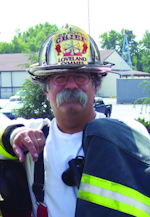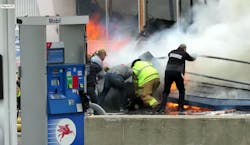We have all seen those small commercial facilities comprised of a gas station and a place to get some basic groceries or a meal. And while they are often not thought of as a significant hazard for firefighters, we only need to look back at our history of tragic outcomes in these small buildings to see that there is nothing small about the risk. While there have been many such incidents, two in particular came to mind when I worked on this month’s Close Calls column.
Two tragedies
The first incident involved two firefighters—Kimberly Smith and Lewis Mayo—who died when a roof collapsed at a McDonald’s restaurant fire in Houston on the morning of Feb. 14, 2000. Firefighter Smith, 30, was a six-year career firefighter with the department and was engaged. Fire Engineer/Operator Mayo, 44, was a 19-year department veteran and dad to three children. Smith and Mayo were part of Engine 76, among the first alarm companies on the scene, finding fire through a portion of the roof on arrival.
About 20 minutes into the fire, the incident commander (IC) ordered firefighters out of the building, but before E-76’s crew could back out, a large air-conditioning unit fell through the roof, separating and disorienting the crew. They were able to find the hoseline and follow it out. Mayo’s PASS device activated, and firefighters were able to locate and remove him within 30 minutes. Firefighters continued their efforts to recover Smith, but as time passed, it became more likely she could not be alive. Her body was found four hours later, buried under rubble a few feet from the rear exit.
The second tragedy that came to mind occurred in Orange County, FL. Firefighter Mark Benge was one of three firefighters on Engine 36 who responded to the report of fire in a lightweight truss T-shirt store. After helping to force entry into the store (with nothing showing), he started pulling ceiling tiles over the entrance door. Finding no fire, Benge continued to pull ceiling tiles as Engineer Todd Aldridge and Firefighter Richard Marcotte stretched a 1¾-inch line into the store. As they moved in, the roof suddenly began to collapse. Benge pushed Marcotte up against the wall and turned to help Aldridge. It is believed that just as he did so, the entire roof must have caved in on both Aldridge and Benge. Marcotte was not seriously injured and managed to crawl to the glass door and break his way out with his SCBA bottle. Rescue attempts were made by additional units, but the fire took off with such intensity that the rescue failed.
While those two fires and the brave sacrifices made by the firefighters involved have helped improve how fire departments operate, the risk of small commercial structures continues to be a serious—and regularly encountered—hazard for all firefighters.
Iron Mountain incident
This month we head to the upper peninsula of Michigan and to the Iron Mountain Fire Department (IMFD) to review a May 20, 2017, incident in which a firefighter was injured when trapped in a building collapse. The department is led by Jeff Friedenstab, deputy director of fire services, who was IC for this fire.
The IMFD is comprised of seven full-time employees, and at the time of the fire, 13 part-time employees. Each shift is comprised of two to three full-time employees and one to two part-time employees:
- Shift 1 – Deputy director of fire services, engineer and two part-time firefighters
- Shift 2 – Captain, engineer and two part-time firefighters
- Shift 3 – Captain, engineer, engine operator and one part-time firefighter
In 2017, IMFD handled 311 calls for service. At the time of this fire, IMFD’s fleet consisted of four vehicles, including two that responded the day of the incident:
- E2202 (primary engine) is a 2002 Pierce featuring a 1,500-gpm Waterous pump, 500-gallon water tank, 1,200 feet of 5-inch large-diameter hose (LDH), and 1,200 feet 2½-inch hose. It has two 2½-inch preconnects (one above pump panel with adjustable nozzle and one at the rear with the Blitzforce monitor) and three 1¾-inch preconnects.
- E2203 (second out/reserve engine) is a 1990 Pierce featuring a 1,250-gpm Waterous pump, a 500-gallon tank, 1,100 feet of 4-inch LDH, and 1,200 feet of 2½-inch hose. It also has one 2½-inch preconnect at the rear with the Blitzforce nozzle, two 1¾-inch preconnects and one 1½-inch bumper line.
Initial actions
On May 20, 2017, at 3:11 p.m., IMFD E2202 Shift 1 turned out for a reported commercial building fire. It was not known if the building was occupied. As soon as units rolled out the door, a large column of smoke was visible and a Code 3 was transmitted, requesting a call-back of all personnel.
Upon arrival, units had heavy smoke and fire showing from the building with heavy wind conditions (14–18 mph) with cloudy and rainy weather. The building was 75 x 70 feet and built of lightweight wood-frame construction with a wood truss and rubber roof.
Water supply was secured at approximately 3:19 p.m. The initial hydrant on U.S. Highway 2 (US 2) was bypassed to use a private hydrant that was thought to be more reliable than the US 2 hydrants and that would also be closer and not block a lane of traffic. But when they went to hook up to the private hydrant that was supposed to be on the corner of the access roads, it was not there. So the apparatus engineer, with the assistance from an off-duty Wisconsin firefighter and the officer, hand-jacked 400 feet of 5-inch supply line to the next closest hydrant. The officer set up E2202 to receive water while the engineer set up the hydrant.
Friedenstab put out a request for mutual aid to Breitung Township Station 1 (Quinnessec) at 3:22 p.m. The Quinnessec station chief arrived on scene prior to the arrival of any of his apparatus or firefighters, performed a face-to-face with Friedenstab, who provided orders for the mutual-aid’s crew as to the hydrant to tag, to put a master stream into operation and to put out two more 2½-inch handlines.
To attack the heavy fire conditions, one firefighter advanced an initial 1¾-inch handline to the Alpha side of the building while the Blitzforce (fed by a 2½-inch line) was being set up. The Blitzforce nozzle—pulled shortly after the 1¾-inch line—was in operation at the time of the collapse. They also had a second 2½-inch line on the ground and ready to be put into service.
Firefighter trapped
Moments prior to the collapse, the IC directed the firefighter on the 1¾-inch line to pull back and staff that 2½-inch line, which was pulled by the IC and in position. As this firefighter—a 24-year-old male—was flowing water on the Alpha/Delta side, part of the front of the roof façade and wall collapsed onto the firefighter, briefly trapping him. Firefighters immediately went in to rescue the firefighter. As the firefighter on the Blitzforce flowed water onto and around the trapped firefighter, others pulled the firefighter to safety.
The arrival of the first mutual-aid apparatus, Engine 471 (E471), occurred simultaneously with the collapse at 3:29 p.m. Two firefighters arrived in E471, which is a 1,250-gpm pump with a 1,000-gallon tank. Two additional firefighters arrived shortly thereafter in Tender 479, which was only used as transportation. Three additional Quinnessec firefighters arrived later in personal vehicles.
The firefighter was extricated from the collapse at 3:32 p.m., aided by the crew of E2202, on-scene law enforcement and EMS personnel, as well as the off-duty firefighter from Wisconsin. Integrity Care EMS started care on scene, and the firefighter was transported to the hospital.
IMFD E2203 was en route with recalled personnel at 3:33 p.m. and arrived on scene with two members at 3:38 p.m. Request for staffing from Breitung Township Station 2 (East Kingsford) was made at 4:27 p.m.; this request brought an additional six firefighters to the scene for rehab efforts.
All units were clear of the scene by 7:54 p.m. The injured firefighter was treated for first- and second-degree burns to his arms and legs and released from the hospital about five hours after the incident.
Note: Watch video of this incident below.
Lessons learned and discussion with Friedenstab
There is no question that many rural fire departments face numerous challenges. From funding to staffing to time/distance response to water supply and so much more, their risk is certainly predictable. Unfortunately, for a variety of reasons, those challenges continue, often due to the lack of funding to increase staffing, improve equipment, etc.
In this case, everyone on the fireground was attempting to perform numerous tasks—get water supply established, lines stretched and begin extinguishment. Unfortunately, not long after the first lines were advanced and started flowing water, the collapse and mayday event occurred.
Looking back at this, it is a classic example of we, as firefighters, doing our absolute best to help with very limited resources. While our attempts are commendable, they often place us in far more hazardous situations than should be expected. Be it in a rural or big-city area, we can only do so much with what we are given. While this fire could have easily used a response of 20–25 firefighters, that simply was not going to happen. So the question becomes, what CAN we do?
It’s important for fire officials to get the local elected officials (and the public) to fully understand exactly what their firefighters are able to do—and what they simply cannot do. In simple terms, the IMFD firefighters gave the community 100 percent of everything possible with four firefighters at a fire that required at least 20. Why am I using 20? Take a look at the recommended number of personnel based on best practices for the tasks required for this structure with heavy fire and partial collapse:
- 2 – Establish initial water (pump and hydrant)
- 6 – Advance two 2½-inch lines or two ground monitors in position on Alpha
- 6 – Advance two 2½-inch lines or two ground monitors on Bravo and Delta
- 2 – Command officers (providing 360 coverage)
- 4 – Rapid intervention/on deck
There are many more roles not covered here, especially since this will be a defensive operation. Use the same logic if it were an offensive operation (interior attack) and crews had to go interior—the job requires firefighters and determining how many is part of preplanning.
So then what can a department do when they are unable to quickly muster the needed staffing? Ask the question: “What’s the most good we can do with what we have right now?”—and do that.
In this case, heavy-flowing master streams initially without handlines may have been an option. While perhaps not initially identifiable, we now know how much of the structure was involved on arrival and how the handlines didn’t have the impact they had hoped.
One document that is very helpful for all fire departments is the IAFC Safety, Health & Survival section’s “Rules of Engagement,” which can be found at iafcsafety.org/rules-of-engagement-training-poster-released. Here is a brief summary of those rules:
- Size-up to determine what you have, what you want to do, whether you have the resources needed.
- Immediately identify the possibility of people trapped.
- Don’t get hurt trying to save property (or even lives) that clearly cannot be saved.
- Take limited risk in saving property.
- Keep crews together—always.
- Know your air supply, conditions, location and situation at all times.
- You must have a radio.
- Report safety hazards, including tactical issues.
- Get out before you cannot get out.
- Call a mayday if you think you are in trouble.
There is also an IC’s “Rules of Engagement,” which you can also review on the IAFCSafety.org website, and I’d like to point out some excerpts from that document that apply to this Close Call:
If you do not have the resources to safely support and protect firefighters, seriously consider a defensive strategy.
The IMFD did run this fire as a defensive one from the start, as that is exactly what should have been done. Clearly, based upon the construction, fire conditions, partial roof collapse and resources, they did the right thing as far as attacking this as a defensive fire.
The members becoming trapped was a case of not being aware that they were in the collapse zone. It is a strong reminder to be aware of what’s going on around you, even when operating exterior, and be aware of your collapse zone. While the IC (who was also helping get lines pulled and placed—while commanding) did identify that and directed change, the collapse happened seconds after that direction. The video shows the IC providing that direction and then turning back to maintain command.
During the post-incident critique, Friedenstab had learned from his engineer that while he was hooking up the hydrant, he had noticed the roof started to look like it was rippling, but this information never made it to command. It’s a great reminder that when you are operating on the fireground and you see something that concerns you, you must transmit those details to command or the appropriate division. Don’t be shy. If what you see could make a difference in the outcome, transmit the details urgently.
While it would be nice if the department had more staffing, including more officers to function in roles such as division supervisor or safety, they simply don’t, which emphasizes the fact that all firefighters must also be responsible for their own continuous personal safety and survival “size-up.” Don’t let that heavy fire “stare you down”; look up, down and all around. Further, answer the question “what might go wrong here?” and watch for collapse potential, exposure problems, hazards and related risks.
Fortunately, the firefighter was rescued quickly by other firefighters on scene.
Final thoughts
Kids grow up watching movies and reading books showing fire apparatus arriving with numerous firefighters literally hanging all over the rig. Unfortunately, that’s not reality in most of North America. While we always encourage fire leadership to regularly make the case for the correctly needed resources, that simply doesn’t always get approved. We are forced to do our best with what we are funded/provided—and that comes with limitations, limitations that may only be realized after an event, especially by those who are not a part of the fire department. It is unrealistic and unfair for any elected body to expect a 20–30 firefighter “performance” when the funding and system provides for just 10 or even fewer personnel.
In addition to needed funding, creative solutions (think automatic mutual-aid) and other options can increase staffing through collaborative efforts. But be it four firefighters or 40 on the first alarm, the rule still applies: What is the most we can do with the resources we have right now? Training and preplanning is the solution to ensure that we give the public their money’s worth, and we don’t unnecessarily risk our most critical resource—our firefighters.
Our sincere appreciation for cooperation of Deputy Director Friedenstab, along with that of his members and mutual-aid departments. Assisting were Breitung Township Fire Department, Integrity Care EMS, Iron Mountain Police Department, Michigan State Police, Dickinson County Sheriff Department, Kingsford Public Safety Department, Red Cross Support Unit, DTE Energy, We Energies and Iron Mountain Department of Public Works.

Billy Goldfeder
BILLY GOLDFEDER, EFO, who is a Firehouse contributing editor, has been a firefighter since 1973 and a chief officer since 1982. He is deputy fire chief of the Loveland-Symmes Fire Department in Ohio, which is an ISO Class 1, CPSE and CAAS-accredited department. Goldfeder has served on numerous NFPA and International Association of Fire Chiefs (IAFC) committees. He is on the board of directors of the IAFC Safety, Health and Survival Section and the National Fallen Firefighters Foundation.






